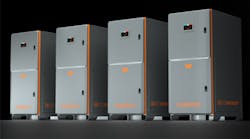Latest from Hydronics Systems
Sponsored
By Gregg Walker
Upgrading to tankless water heaters has become a popular choice among homeowners in recent years—for a variety of reasons.
Whether efficiency, performance, or environmental impact is being prioritized in their search for the best water heating solution, homeowners are finding value in propane tankless water heaters.
Propane tankless systems can reduce energy costs by up to 50 percent, eliminate standby energy loss, provide an endless supply of hot water, and save up to 12 square feet of floor space compared with a standard storage tank model. Plus, they have a life expectancy of approximately 20 years, which is much longer than any conventional storage water heater. They also offer the lowest annual cost-of-ownership in four out of five U.S. climate zones and far better performance than other models tested, according to data from the Propane Education & Research Council.
When it comes to the installation of the equipment, many construction contractors know that tankless water heaters are less labor-intensive to install than their storage tank counterparts. But, while installing a propane tankless water heater is fairly straightforward, it involves more than simply swapping out a tank unit.
Experienced professionals know there’s an art to perfecting a water heater installation. With creative layout solutions, proper installation techniques, and careful planning, pros can minimize an installation’s upfront costs, maximize performance and return on investment, ensure that the tankless unit lasts for its predicted lifespan, and increase customer satisfaction.
Here are five factors to take into consideration to ensure a seamless upgrade:
- Location
Because a tankless system is compact and doesn’t need indoor air for combustion, it can be located in more places than a traditional water heater. That said, the unit should be located in a place that minimizes installation cost and maximizes performance. One way for plumbers to help minimize installation costs for the homeowner is to evaluate the venting, gas, and water lines.
- Waterlines
With storage tank water heaters, the water connections come in at the top, but they have to go in at the bottom of tankless units—meaning a reroute of lines might be required. Finding the least-restrictive way to install a tankless system and reducing the length of water or gas lines can help lower installation costs. If the tank was located in the center of the room before, plumbers will also need to move the waterlines to an exterior wall, where the new tankless unit can more easily vent outside. The type of pipe used for the water will also affect cost. Copper pipes are already present in many retrofits, but PEX or PVC plumbing is less expensive, can be installed more quickly, and is easier to work with.
- Condensate
If the tankless water heater replacement is a condensing unit, plumbers will need to run a condensate line. Because highly acidic condensate can stain concrete or corrode metal pipe, plumbers should use a condensate neutralizer—which contains a base media, such as limestone or marble chips—in a section of pipe. They could also drain the condensate into a plastic or vinyl washing machine drain, as soap will neutralize the condensate.
Although condensing tankless units require an additional step and are a bit more expensive than non-condensing models, their cooler exhaust gas temperatures allow for the use of less-expensive plastic venting pipe, whereas the high-temperature flue gases of non-condensing tankless models require more expensive stainless-steel vents.
- Gas Pressure
Tankless units, when at full power, require between 120,000 and 199,000 Btu—which is three to five times the heating capacity of a tank-type water heater. In many tank system replacement scenarios, plumbers must increase the gas line size from the typical half inch to three-quarter inch. But the higher pressure of propane means that plumbers can sometimes reuse the existing half-inch line for the tankless unit. Depending on the length of the gas line needed, propane systems may not require a larger-diameter gas line, offering installation savings of up to $1,000.
- Technology
Some new tankless systems are even more adept at using a half-inch gas line for either natural gas or propane by using a negative pressure gas valve and the exhaust system fan to pull gas in and stabilize it at 190,000 Btu.
By upgrading to a propane tankless water heater, customers can save big on their energy bills. And by correctly installing the unit, construction professionals and plumbers can ensure that customers get a better return on investment and long-term satisfaction.
Don’t let customers settle for less than propane performance—a level of performance that electric and heating oil systems simply can’t match. For more information on propane water heating technologies, visit Propane.com/Water-Heating.
Gregg Walker is the director of external communications for the Propane Education & Research Council. He can be reached at [email protected].


